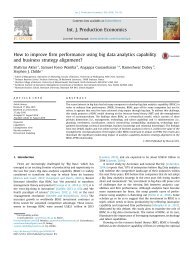Akter, S., Wamba, S. F., Gunasekaran, A., Dubey, R., & Childe, S. J. (2016). How to improve firm performance using BDAC and business strategy alignment.
You also want an ePaper? Increase the reach of your titles
YUMPU automatically turns print PDFs into web optimized ePapers that Google loves.
124<br />
S. <strong>Akter</strong> et al. / Int. J. Production Economics 182 (<strong>2016</strong>) 113–131<br />
Table 10<br />
Assessment of the higher-order, reflective model.<br />
Models Latent constructs AVE CA CR Dimensions Β R 2 t-Statistic<br />
Third-order Big Data Analytics Capability (<strong>BDAC</strong>) 0.577 0.982 0.983 BDAMAC 0.938 0.879 70.756<br />
BDATEC 0.912 0.831 57.490<br />
BDATLC 0.948 0.900 86.239<br />
Second-order BDA Management Capability (BDAMAC) 0.635 0.961 0.965 BDAPL 0.903 0.815 47.238<br />
BDAID 0.888 0.788 37.369<br />
<strong>BDAC</strong>O 0.850 0.723 24.860<br />
<strong>BDAC</strong>T 0.920 0.846 57.554<br />
BDA Technology Capability (BDATEC) 0.600 0.932 0.942 <strong>BDAC</strong>N 0.864 0.747 24.312<br />
<strong>BDAC</strong>M 0.919 0.845 55.863<br />
BDAMD 0.897 0.805 38.407<br />
BDA Talent Capability (BDATLC) 0.722 0.974 0.976 BDATM 0.944 0.858 61.828<br />
BDATK 0.926 0.891 85.388<br />
BDABK 0.934 0.872 59.852<br />
BDARK 0.938 0.881 95.354<br />
multidimensional capability in the big data environment <strong>and</strong> <strong>to</strong><br />
frame its impact on FPER in a nomological network. The findings<br />
show that the higher-order <strong>BDAC</strong> construct has a strong significant<br />
impact on FPER. This result con<strong>firm</strong>s that the emphasis on <strong>BDAC</strong> is<br />
the perfect starting point for identifying <strong>and</strong> solving emerging big<br />
data challenges. These results also put forward the concept of the<br />
‘entanglement view’ in visualizing the multidimensional capability<br />
challenges in the broader data economy.<br />
6. Discussion<br />
Big data analytics capability (<strong>BDAC</strong>) was found <strong>to</strong> have a positive<br />
association with all the primary dimensions with BDA talent<br />
capability (BDATLC) emerging as the strongest. This finding suggests<br />
that greater gains in overall <strong>BDAC</strong> can be achieved by<br />
BDATLC, which is evident in ‘born-through-analytics companies’<br />
such as Facebook <strong>and</strong> Amazon <strong>and</strong> their well-developed recruiting<br />
approaches for analytics talent (Court, 2015). In addition, BDA<br />
management capability (BDAMAC) was identified as a significant<br />
dimension indicating that achieving sustainable competitive advantage<br />
with analytics relies heavily on decision makers. A recent<br />
big data study (involving 2037 professionals <strong>and</strong> interviews with<br />
more than 30 executives in 100 countries <strong>and</strong> 25 industries) reflects<br />
the importance of analytics management as 87% of its respondents<br />
suggest foc<strong>using</strong> on elevating their organizations <strong>to</strong> the<br />
next level of analytics management (Kiron et al., 2014).<br />
BDA technology capability (BDATEC) was identified as a key<br />
component of <strong>BDAC</strong>, emphasizing the need for versatility of the<br />
analytics platform so that it connects data from various functions<br />
across the <strong>firm</strong>, ensures information flow, <strong>and</strong> develops robust<br />
models. In the big data environment, technology flexibility is critical<br />
for embracing voluminous <strong>and</strong> valuable data from a variety of<br />
sources, thus enabling <strong>firm</strong>s <strong>to</strong> swiftly implement models (Bar<strong>to</strong>n<br />
<strong>and</strong> Court, 2012). Although the study has prioritized the importance<br />
of the overall <strong>BDAC</strong> dimensions in terms of explained<br />
variance, it recommends that equal attention should be paid <strong>to</strong> all<br />
the dimensions <strong>to</strong> achieve successful application in big data<br />
functions, for ex<strong>amp</strong>le, logistics, risk management, pricing, cus<strong>to</strong>mer<br />
service, <strong>and</strong> personnel management. Overall, the findings of<br />
the structural model con<strong>firm</strong> that <strong>BDAC</strong> is a significant predic<strong>to</strong>r of<br />
FPER (explaining 50% of the variance). These findings con<strong>firm</strong><br />
ACBSA as the significant modera<strong>to</strong>r or the necessary condition for<br />
strong <strong>firm</strong> <strong>performance</strong> (FPER). The interaction model explained<br />
around 60% of the variance. Overall, these findings suggest that big<br />
data <strong>firm</strong>s should consider higher-order <strong>BDAC</strong> <strong>and</strong> ACBSA as important<br />
strategic antecedents <strong>to</strong> influence <strong>firm</strong> <strong>performance</strong><br />
(FPER).<br />
6.1. Theoretical contributions<br />
This study makes several contributions <strong>to</strong> <strong>BDAC</strong> research.<br />
Firstly, the study develops the scale of three primary <strong>BDAC</strong> constructs,<br />
<strong>and</strong> 11 sub-constructs <strong>and</strong> their associated measurement<br />
items against the backdrop of capability research in big data<br />
analytics (BDA). The findings therefore contribute <strong>to</strong> answering<br />
Table 11<br />
Results of structural model.<br />
Path coefficients St<strong>and</strong>ard error t-Statistic R 2 f 2<br />
Main model<br />
<strong>BDAC</strong>-FPER 0.709 0.053 13.265 0.503 n.a.<br />
Interaction model<br />
<strong>BDAC</strong>-FPER 0.261 0.102 2.558 0.596<br />
ACBSA-FPER 0.542 0.102 5.319<br />
<strong>BDAC</strong>*-FPER 0.153 0.079 1.937<br />
ACBSA<br />
R2 − R<br />
2<br />
2<br />
f = i m<br />
1 − R2<br />
i<br />
0.596 − 0.503<br />
= = 0.23<br />
1 − 0.596<br />
(Here, i¼interaction model, m¼main effect model)<br />
Control model<br />
<strong>BDAC</strong>-FPER 0.694 0.053 13.048 0.514<br />
R<br />
2<br />
−<br />
f = c R<br />
2<br />
2 m<br />
1 − R<br />
2 c<br />
0.514 − 0.503<br />
= = 0.02<br />
1−<br />
0.514<br />
COVA-FPER 0.101 0.076 1.335 (Here, c¼model with control variables, model, m¼main effect model)




